Discover Florida Nature
It's time to explore the natural Florida


|
|
|
|
|
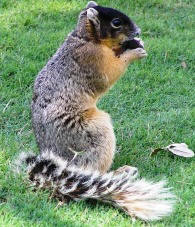 Big
Cypress Fox Squirrel (Sciurus niger avicennia) Threatened- Fox
squirrels may have earned their name from their gray and red fur coat
that resemble that of a gray fox, from their comparatively large size
and thick bushy tail, and/or from peculiar way of running along the
ground which gives the appearance of a small fox. The Big Cypress Fox
Squirrel is found from the Caloosahatchee River in Lee county south and
then east to the southern part of Dade county. Contrary to two common
names sometimes given to the Big Cypress Fox Squirrel -- Mangrove Fox
Squirrel and Everglades Fox Squirrel -- it is not common in either
mangrove or Everglades habitats. It is most common in open pinelands,
live oak forests, and stands of bigger bald cypress. Big
Cypress Fox Squirrel (Sciurus niger avicennia) Threatened- Fox
squirrels may have earned their name from their gray and red fur coat
that resemble that of a gray fox, from their comparatively large size
and thick bushy tail, and/or from peculiar way of running along the
ground which gives the appearance of a small fox. The Big Cypress Fox
Squirrel is found from the Caloosahatchee River in Lee county south and
then east to the southern part of Dade county. Contrary to two common
names sometimes given to the Big Cypress Fox Squirrel -- Mangrove Fox
Squirrel and Everglades Fox Squirrel -- it is not common in either
mangrove or Everglades habitats. It is most common in open pinelands,
live oak forests, and stands of bigger bald cypress. 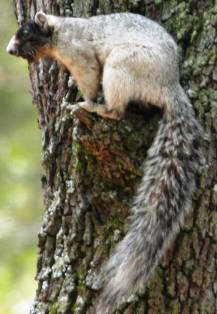 Sherman’s
Fox Squirrel
(Sciurus niger shermani) SSC- The Sherman fox squirrel is found in
peninsular Florida to the north end of Lake Okeechobee. Its preferred
habitat is pine forests of longleaf pine or South Florida slash pine,
where it eats pine seeds and acorns. The Sherman fox squirrel is rarely
seen in urban areas. Fox squirrels weigh from one to three pounds, and
exhibit color variations which range from a buff color to gray, and in
some instances black. The under parts are usually lighter, and typical
specimens have white noses with black faces and feet. They are noted for
their long, bushy tails and for their strong hind legs which allows them
to leap easily from place to place. Sherman’s
Fox Squirrel
(Sciurus niger shermani) SSC- The Sherman fox squirrel is found in
peninsular Florida to the north end of Lake Okeechobee. Its preferred
habitat is pine forests of longleaf pine or South Florida slash pine,
where it eats pine seeds and acorns. The Sherman fox squirrel is rarely
seen in urban areas. Fox squirrels weigh from one to three pounds, and
exhibit color variations which range from a buff color to gray, and in
some instances black. The under parts are usually lighter, and typical
specimens have white noses with black faces and feet. They are noted for
their long, bushy tails and for their strong hind legs which allows them
to leap easily from place to place. 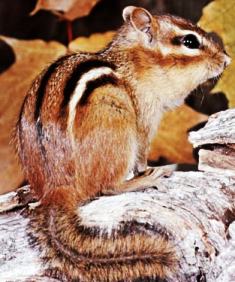 Eastern
Chipmunk
(Tamias striatus) SSC- The eastern chipmunk has reddish-brown fur on its
back and sides and white fur on its stomach. It has two white stripes
bordered by black on its sides and one black stripe on the center of its
back. The eastern chipmunk has light stripes above and below its eyes
and it has pouched cheeks that it uses to store and carry food. Most of
the eastern chipmunk's diet is made up of nuts, acorns, seeds,
mushrooms, fruits, berries and corn. It also eats insects, bird eggs,
snails and small mammals like young mice. The eastern chipmunk lives in
open deciduous forests and at the edges of woodlands. It can also be
found in bushy areas and in rocky areas like walls near houses and other
buildings. Eastern chipmunks are also very vocal and can be heard
chattering as they gather food. In fact, they get their name chipmunk
from the "chip-chip" sound that they make! Eastern
Chipmunk
(Tamias striatus) SSC- The eastern chipmunk has reddish-brown fur on its
back and sides and white fur on its stomach. It has two white stripes
bordered by black on its sides and one black stripe on the center of its
back. The eastern chipmunk has light stripes above and below its eyes
and it has pouched cheeks that it uses to store and carry food. Most of
the eastern chipmunk's diet is made up of nuts, acorns, seeds,
mushrooms, fruits, berries and corn. It also eats insects, bird eggs,
snails and small mammals like young mice. The eastern chipmunk lives in
open deciduous forests and at the edges of woodlands. It can also be
found in bushy areas and in rocky areas like walls near houses and other
buildings. Eastern chipmunks are also very vocal and can be heard
chattering as they gather food. In fact, they get their name chipmunk
from the "chip-chip" sound that they make!
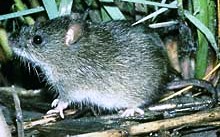 Silver
Rice Rat
( Oryzomys argentatus) Endangered- Silver rice rat occupy
wetland areas on 12 islands in the lower Florida Keys. The silver rice
rat is of generalized rat-like appearance, with a slender skull and
coarse fur which is colored silver-gray along its back. This rat has a
sparsely-haired tail and reaches 250 millimeters (10 inches) in total
length. The silver rice rat differs from the more common marsh rice rat
by its rarity, larger body size, lower fecundity, and larger home range
size. Populations of these rice rats are found at extremely low
densities on 12 islands in the Lower Keys and were listed as endangered
primarily because their wetland habitat had been destroyed by
residential and commercial construction activities. Silver
Rice Rat
( Oryzomys argentatus) Endangered- Silver rice rat occupy
wetland areas on 12 islands in the lower Florida Keys. The silver rice
rat is of generalized rat-like appearance, with a slender skull and
coarse fur which is colored silver-gray along its back. This rat has a
sparsely-haired tail and reaches 250 millimeters (10 inches) in total
length. The silver rice rat differs from the more common marsh rice rat
by its rarity, larger body size, lower fecundity, and larger home range
size. Populations of these rice rats are found at extremely low
densities on 12 islands in the Lower Keys and were listed as endangered
primarily because their wetland habitat had been destroyed by
residential and commercial construction activities.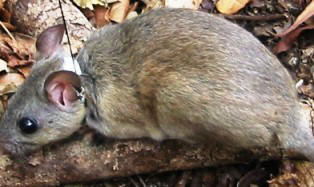 Key
Largo Woodrat (Neotoma floridana smalli) Endangered- The Key
Largo woodrat is found in the tropical hardwood hammocks of Key Largo,
Florida. Currently, we estimate less than 100 woodrats exist throughout
their range .Scientists aren't sure what's caused the population crash
of the endangered Key Largo Wood rat. The color of the Key Largo woodrat
is described as sepia or grey-brown above shading into cinnamon on the
sides, with cream or white ventral coloration. The forefeet are white to
the wrist and the hind feet are primarily white to the ankles. The Key
Largo woodrat has large ears, protuberant eyes, and a hairy tail. The
head-and-body-length of the Key Largo woodrat ranges from 120 to 230
mm, and their tail length ranges from 130 to 190 mm. Males, on average,
weigh 258 g, while the females tend to be much smaller, weighing only
210 g. Key Largo woodrats are nocturnal omnivores, but feed primarily on
a variety of leaves, buds, seeds, and fruit. Key
Largo Woodrat (Neotoma floridana smalli) Endangered- The Key
Largo woodrat is found in the tropical hardwood hammocks of Key Largo,
Florida. Currently, we estimate less than 100 woodrats exist throughout
their range .Scientists aren't sure what's caused the population crash
of the endangered Key Largo Wood rat. The color of the Key Largo woodrat
is described as sepia or grey-brown above shading into cinnamon on the
sides, with cream or white ventral coloration. The forefeet are white to
the wrist and the hind feet are primarily white to the ankles. The Key
Largo woodrat has large ears, protuberant eyes, and a hairy tail. The
head-and-body-length of the Key Largo woodrat ranges from 120 to 230
mm, and their tail length ranges from 130 to 190 mm. Males, on average,
weigh 258 g, while the females tend to be much smaller, weighing only
210 g. Key Largo woodrats are nocturnal omnivores, but feed primarily on
a variety of leaves, buds, seeds, and fruit.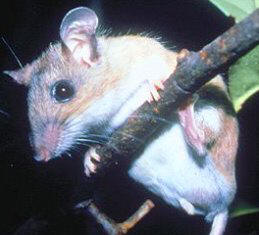 Key
Largo Cotton Mouse
(Peromyscus gossypinus allapaticola) Endangered- This mouse
only seems to thrive in the Hardwood Hammock Forests of Key Largo,
Monroe County, Florida. This is the only location the mouse can be
found. Key Largo cotton mice are larger with a more reddish color than
other subspecies of cotton mice from peninsular Florida. Its pelage is
red dorsally, with dusky brown sides and white under parts. Its
bi-colored tail is darker brown on top and whiter underneath. Body
length is 170 to 189 mm, tail length is 72 to 87 mm, and hind foot
length is 21 to 23 mm. Key Largo cotton mice are
omnivorous and feed on a wide variety of plant and animal materials. Key
Largo Cotton Mouse
(Peromyscus gossypinus allapaticola) Endangered- This mouse
only seems to thrive in the Hardwood Hammock Forests of Key Largo,
Monroe County, Florida. This is the only location the mouse can be
found. Key Largo cotton mice are larger with a more reddish color than
other subspecies of cotton mice from peninsular Florida. Its pelage is
red dorsally, with dusky brown sides and white under parts. Its
bi-colored tail is darker brown on top and whiter underneath. Body
length is 170 to 189 mm, tail length is 72 to 87 mm, and hind foot
length is 21 to 23 mm. Key Largo cotton mice are
omnivorous and feed on a wide variety of plant and animal materials.
|
|
|
Advertise | Privacy Statement | Dog Encyclopedia | Video |Contact | Alaska Nature |
|